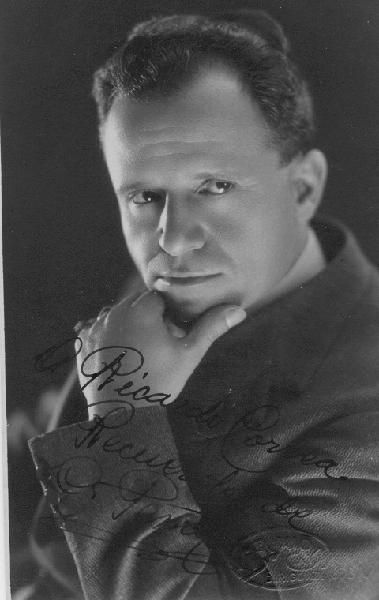Cayetano Peñalver
Cayetano Peñalver used to be a household name in Spanish newspapers from the 1910s to the mid-1930s; today, he is so totally forgotten
that not even the most basic biographical sketch exists anywhere about him. He sang exclusively Spanish works, which means: mostly zarzuela;
his only opera would seem to have been Marina.
He seems to have started his career in 1911 in his native Madrid, at the small Teatro Royal Kursaal.
In 1913, he was a member of the Teatro de la Zarzuela in Madrid; later the same year, as a soldier in the Spanish army, he fought in the Second
Melillan Campaign and was wounded in December.
In 1915, he sang at the Teatro Real in Madrid, in Marina, with Graziella Pareto and José Segura-Tallien.
He married María del Carmen Méndez in Cádiz in October 1917.
After the First World War, he must have been primarily in Barcelona; when he returned to Madrid in July 1923 (Jugar con fuego by
Barbieri, with the troupe of Eugenio Casals at the Teatro de Maravillas), it was announced as his Madrid debut (not true, as we know, but
obviously, his 1911 to 1915 appearances in Madrid had not left any lasting impression).
In the 1920s, his career really took steam; he sang in most every city and town around Spain, and in almost every theater that staged zarzuela
(only for the Liceu in Barcelona, I didn't find any evidence). He was by turns a member of resident and of itinerant companies, for instance
of the one of Emilio Sagi-Barba. He took part in a lot of world premieres, one of which is the only reason why his name is still occasionally
remembered: Jesús Guridi's El caserío at the Teatro de la Zarzuela on 11 November 1926, with Felisa Herrero, José
Luis Lloret and Antonio Palacios.
From 1928, he strived to form his own company; the one that he founded in 1930 together with María
Badía and Luis Almodóvar was particularly successful, but he ran other zarzuela companies, too, alone or with changing partners.
As far as guest appearances abroad, I only found him at the Teatro Avenida in Buenos Aires in the 1920s (no details available, unfortunately).
He was 44 when he died from a chronic ailment, but unexpectedly nonetheless: only two days before his death, he had appeared in La
Dolorosa at the Teatro Lope de Vega in Valladolid.
References:
I wish to thank Vladimir Efimenko for the recording. |
